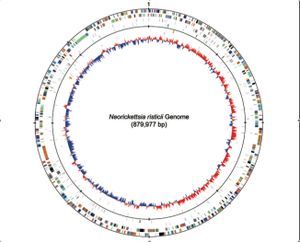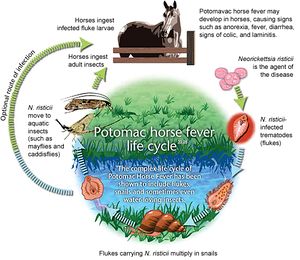Neorickettsia risticii: Difference between revisions
| Line 5: | Line 5: | ||
[[File:PHF-genome.jpg|thumb|''Neorickettsia risticii genome'' [http://nar.oxfordjournals.org/content/37/18/6076/F2.small.gif]]] | [[File:PHF-genome.jpg|thumb|''Neorickettsia risticii genome'' [http://nar.oxfordjournals.org/content/37/18/6076/F2.small.gif]]] | ||
Neorickettsia risticii, formerly called Ehrlichia risticii, belong to the Anaplasmataceae family, the Rickettsiales order, and the Neorickettsia genus. N. risticii was discovered in 1979 during an outbreak of Potomac Horse Fever along the Potomac River in Maryland and Virginia. It is a gram-negative, coccus, and obligate bacterium [3]. N. risticii was demonstrated to be the sole causative agent of Potomac Horse Fever by fulfilling Koch's Postulates in 1985. | ''Neorickettsia risticii'', formerly called ''Ehrlichia risticii'', belong to the Anaplasmataceae family, the Rickettsiales order, and the Neorickettsia genus. ''N. risticii'' was discovered in 1979 during an outbreak of Potomac Horse Fever along the Potomac River in Maryland and Virginia. It is a gram-negative, coccus, and obligate bacterium [3]. ''N. risticii'' was demonstrated to be the sole causative agent of Potomac Horse Fever by fulfilling Koch's Postulates in 1985. | ||
The genome for Neorickettsia risticii was fully sequenced in 2009. The Neorickettsia risticii strain sequenced was the Illinois strain, which consists of one circular chromosome that has 879,977 base pairs, with a G-C content of 41.3%. This chromosome encodes for 38 different RNA species, including a 16s RNA, and 898 different proteins [4]. | The genome for ''Neorickettsia risticii'' was fully sequenced in 2009. The ''Neorickettsia risticii'' strain sequenced was the Illinois strain, which consists of one circular chromosome that has 879,977 base pairs, with a G-C content of 41.3%. This chromosome encodes for 38 different RNA species, including a 16s RNA, and 898 different proteins [4]. | ||
==Characteristics of the host== | ==Characteristics of the host== | ||
Revision as of 23:51, 29 November 2011
WIKI IN PROGRESS
Ex. Potomac Horse Fever
Characteristics of the pathogen

Neorickettsia risticii, formerly called Ehrlichia risticii, belong to the Anaplasmataceae family, the Rickettsiales order, and the Neorickettsia genus. N. risticii was discovered in 1979 during an outbreak of Potomac Horse Fever along the Potomac River in Maryland and Virginia. It is a gram-negative, coccus, and obligate bacterium [3]. N. risticii was demonstrated to be the sole causative agent of Potomac Horse Fever by fulfilling Koch's Postulates in 1985.
The genome for Neorickettsia risticii was fully sequenced in 2009. The Neorickettsia risticii strain sequenced was the Illinois strain, which consists of one circular chromosome that has 879,977 base pairs, with a G-C content of 41.3%. This chromosome encodes for 38 different RNA species, including a 16s RNA, and 898 different proteins [4].
Characteristics of the host
The target host for pathogenesis is Equus caballus, or the horse. N. risticii ,however, being an obligate bacterium has to live within another organism for it to be able to survive. It usually lives in aquatic insects, such as the caddisfly or mayfly, or in flukes. The relationship between N. risticii and these other organisms is unknown, but it is not a pathogenic one.

Host-Symbiont Interaction
The interaction between N. risticii and the horse is a pathogenic one. Infection of a horse with N. risticii causes Potomac Horse Fever, also known as Equine Ehrlichial Colitis, an acute and potentially fatal disease.
N. risticii is an obligate parasite, meaning it cannot survive without a host. It uses a trematode, otherwise known as a fluke, to survive and proliferate [5]. Flukes tend to multiply within snails, and then lay larvae. Or N. risticii uses other aquatic vectors, such as the mayfly or caddisfly, to survive and proliferate [6]. It is through ingestion of fluke larvae or one of these aquatic vectors that the horse becomes infected with N. risticii and contracts Potomac Horse Fever.
Once inside the horse,the bacteria colonizes in the epithelial cells of the horses intestines, monocytes in the blood, and macrophages in the lymphoids and other tissues [5]. N. risticii infection causes many adverse symptoms such as anorexia, fever, depression, diarrhea, lethargy, and in some cases laminitis. N. risticii is also known to cause miscarriages in pregnant horses [5].
Molecular Insights into the Symbiosis
A 51-kDa protein, P51, is the specific antigen recognized in horses with PHF. P51 is encoded by the p51 gene, which is not found in any other bacteria based, and has been found in all N. risticii strains identified to date. P51 is most likely to be a surface protein.
Neorickettsia sennetsu is another bacterium in the same family as N. risticii and causes human sennetsu rickettsiosis. Despite very close genome symmetry between N. risticii and N. sennetsu, 140 and 177 genes are unique to each organism, respectively. N. sennetsu is not pathogenic to horses, and inoculating horses with N. sennetsu actually acts as a vaccine for the horse against PHF, preventing the horse from being infected with N. risticii.
Ecological and Evolutionary Aspects
This disease is most common to occur in the late spring and summer. This is due to the fact that the aquatic insects are laying larvae and reproducing, same with the flukes. This gives N. risticii more reservoirs to thrive in, and ultimately increases a horses chances of drinking water carrying a contaminated insect or fluke.
Recent Discoveries
Describe two findings on the symbiosis published within the last two years.
References
[1] []
[2] [3]
[3][Chaichanasiriwithaya, W., Rikihisa, Y., Yamamoto, S., Reed, S., Crawford, T., Perryman, L., and Palmer, G. 1994. Antigenic, morphologic, and molecular characterization of new Ehrlichia risticii isolates. Journal of Clinical Microbiology. 38: 3026-3033.]
[4][Lin, M., Zhang, C., Gibson, K., and Rikihisa, Y. 2009. Analysis of complete genome sequence of Neorickettsia risticii: causative agent of potomic horse fever. Nucleic Acid Research. 37 (18): 6076-6091.]
[5][Mott, J., Muramatus, Y., Seaton, E., Martin, C., Reed, S., and Rikihisa, Y. 2002. Molecular analysis of Neorickettsia risticii in adult aquatic insects in Pennsylvania, in horses infected by ingestion of insects, and isolated in cell culture. Journal of Clinical Microbiology. 40(2): 690-693.]
[6][Wilson, J., Pusterla, N., Bengfort, J., and Arney, L. 2006. Incrimination of mayflies as a vector of Potomac horse fever in an outbreak in Minnesota. American Association of Equine Practitioners. 52: 324-328.]
Edited by [Sierra Wangensteen], student of Grace Lim-Fong
